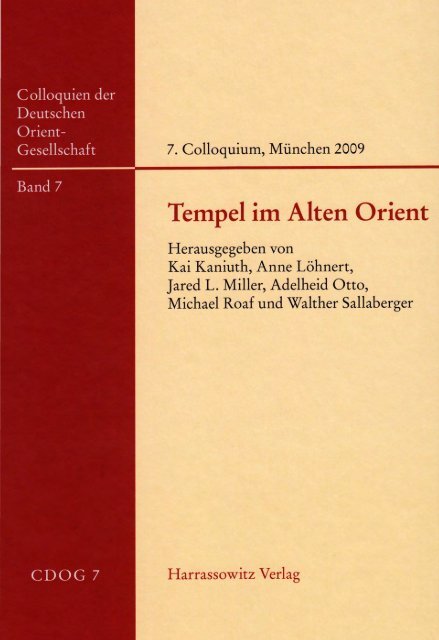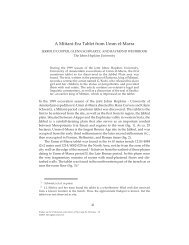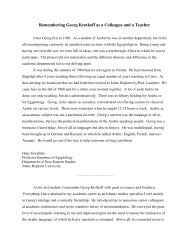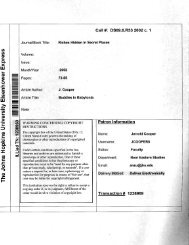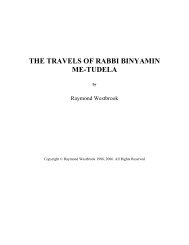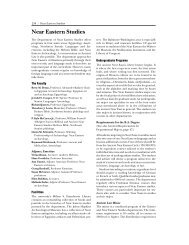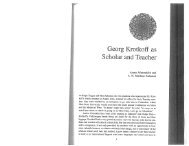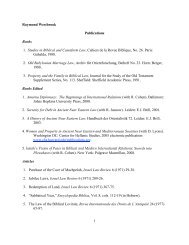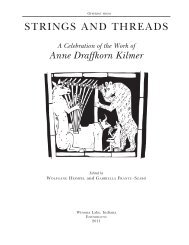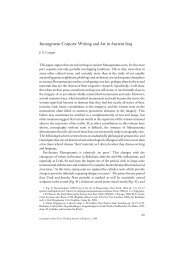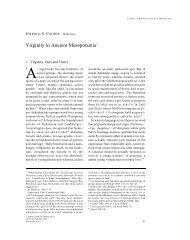Sex and the Temple - Near Eastern Studies
Sex and the Temple - Near Eastern Studies
Sex and the Temple - Near Eastern Studies
You also want an ePaper? Increase the reach of your titles
YUMPU automatically turns print PDFs into web optimized ePapers that Google loves.
7. Colloquium, München 2009<br />
Tempel im Alten Orient<br />
Herausgegeben von<br />
Kai Kaniuth, Anne Löhnert,<br />
Jared L. Miller, Adelheid Otto,<br />
Michael Roaf und Wal<strong>the</strong>r Sallaberger<br />
Harrassowitz Verlag
Colloquien der Deutschen Orient-Gesellschaft<br />
B<strong>and</strong> 7<br />
2013<br />
Harrassowitz Verlag· Wiesbaden
Tempel im Alten Orient<br />
7. Internationales Colloquium<br />
der Deutschen Orient-Gesellschaft<br />
11.-13. Oktober 2009, München<br />
Im Auftrag des Vorst<strong>and</strong>s<br />
der Deutschen Orient-Gesellschaft<br />
herausgegeben von<br />
Kai Kaniuth, Anne Löhnert, Jared L. Miller,<br />
Adelheid Otto, Michael Roaf<br />
und Wal<strong>the</strong>r Sallaberger<br />
2013<br />
Harrassowitz Verlag' Wiesbaden
Die Bände 1-3 der Reihe sind in der Saarländischen Druckerei & Verlag GmbH,<br />
Saarwellingen erschienen.<br />
Bibliografische Information der Deutschen Nationalbiblio<strong>the</strong>k<br />
Die Deutsche Nationalbiblio<strong>the</strong>k verzeichnet diese Publikation in der Deutschen<br />
Nationalbibliografie; detaillierte bibliografische Daten sind im Internet<br />
über http://dnb.dnb.deabrufbar.<br />
Bibliographie information published by <strong>the</strong> Deutsche Nationalbiblio<strong>the</strong>k<br />
The Deutsche Nationalbiblio<strong>the</strong>k lists this publication in <strong>the</strong> Deutsche<br />
Nationalbibliografie; detailed bibliographie data are available in <strong>the</strong> internet<br />
at http://dnb.dnb.de.<br />
Informationen zum Verlagsprogramm finden Sie unter<br />
http://www.harrassowitz-verlag.de<br />
© Otto Harrassowitz GmbH & Co. KG, Wiesbaden 2013<br />
Das Werk einschließlich aller seiner Teile ist urheberrechtlich geschützt.<br />
Jede Verwertung außerhalb der engen Grenzen des Urheberrechtsgesetzes ist ohne<br />
Zustimmung des Verlages unzulässig und strafbar. Das gilt insbesondere<br />
für Vervielfältigungen jeder Art, Übersetzungen, Mikroverfilmungen und<br />
für die Einspeicherung in elektronische Systeme.<br />
Gedruckt auf alterungsbeständigem Papier.<br />
Druck und Verarbeitung: Memminger MedienCentrum AG<br />
Printed in Germany<br />
ISSN 1433-7401<br />
ISBN 978-3-447-06774-4
Inhalt<br />
Vorwort ............................................................... VII<br />
Teilnehmer ............................................................. IX<br />
Vortrags-Programm ..................................................... XI<br />
Wilfrid Allinger-Csollich<br />
Gedanken über das Aussehen und die Funktion einer Ziqqurrat ....... 1<br />
Claus Ambos<br />
Rituale beim Abriß und Wiederaufbau eines Tempels ............... 19<br />
Reinhard Bernbeck<br />
Religious Revolutions in <strong>the</strong> Neolithic? “<strong>Temple</strong>s” in Present<br />
Discourse <strong>and</strong> Past Practice ...................................... 33<br />
Jerrold S. Cooper<br />
<strong>Sex</strong> <strong>and</strong> <strong>the</strong> <strong>Temple</strong> .............................................. 49<br />
Margarete van Ess<br />
Babylonische Tempel zwischen Ur III- und neubabylonischer Zeit:<br />
Zu einigen Aspekten ihrer planerischen Gestaltung und religiösen<br />
Konzeption ..................................................... 59<br />
Frederick Mario Fales<br />
The <strong>Temple</strong> <strong>and</strong> <strong>the</strong> L<strong>and</strong> ........................................ 85<br />
Uri Gabbay<br />
The Performance of Emesal Prayers within <strong>the</strong> Regular <strong>Temple</strong> Cult:<br />
Content <strong>and</strong> Ritual Setting ....................................... 103<br />
Susanne Görke<br />
Hethitische Rituale im Tempel .................................... 123<br />
Markus Hilgert<br />
„Tempelbiblio<strong>the</strong>k“ oder „Tafeldepot“?<br />
Zum rezeptionspraktischen Kontext der „Sippar-Biblio<strong>the</strong>k“ ......... 137<br />
Michael Jursa (Wien)<br />
Die babylonische Priesterschaft im ersten Jahrtausend v. Chr. ........ 151
VI<br />
Inhalt<br />
Kristin Kleber<br />
The Late Babylonian <strong>Temple</strong>: Economy, Politics <strong>and</strong> Cult ............ 167<br />
Kay Kohlmeyer<br />
Der Tempel des Wettergottes von Aleppo .......................... 179<br />
Walter Kuntner und S<strong>and</strong>ra Heinsch<br />
Die babylonischen Tempel in der Zeit nach den Chaldäern ........... 219<br />
Anne Löhnert<br />
Das Bild des Tempels in der sumerischen Literatur .................. 263<br />
Nicolò Marchetti<br />
Mesopotamian Early Dynastic Statuary in Context .................. 283<br />
Stefan M. Maul<br />
Das Haus des Götterkönigs: Gedanken zur Konzeption überregionaler<br />
Heiligtümer im Alten Orient ...................................... 311<br />
Wiebke Meinhold<br />
Tempel, Kult und Mythos: Zum Verhältnis von Haupt- und<br />
Nebengot<strong>the</strong>iten in Heiligtümern der Stadt Aššur ................... 325<br />
Andreas Müller-Karpe<br />
Einige archäologische sowie archäoastronomische Aspekte<br />
hethitischer Sakralbauten ........................................ 335<br />
Adelheid Otto<br />
Gotteshaus und Allerheiligstes in Syrien und Nordmesopotamien<br />
während des 2. Jts. v. Chr. ........................................ 355<br />
Frances Pinnock<br />
Syrian <strong>and</strong> North Mesopotamian <strong>Temple</strong>s in <strong>the</strong> Early Bronze Age ... 385<br />
Shahrokh Razmjou <strong>and</strong> Michael Roaf<br />
<strong>Temple</strong>s <strong>and</strong> Sacred Places in Persepolis ........................... 407<br />
Michael Roaf<br />
<strong>Temple</strong>s <strong>and</strong> <strong>the</strong> Origin of Civilisation ............................. 427<br />
Ingo Schrakamp<br />
Die „Sumerische Tempelstadt“ heute: Die sozioökonomische Rolle<br />
eines Tempels in frühdynastischer Zeit ............................ 445<br />
Ursula Seidl<br />
Bildschmuck an mesopotamischen Tempeln des<br />
2. Jahrtausends v. Chr. ........................................... 467<br />
Indices ................................................................ 489
Vorwort<br />
Tempel prägten die altorientalischen Kulturen in mehrfacher Hinsicht entscheidend:<br />
Als zentrale Institutionen nahmen sie einen herausragenden Rang in der Gesellschaft<br />
ein, als monumentale Baukomplexe bildeten sie die architektonischen Mittelpunkte<br />
der Städte. In ihnen konzentrierte sich der religiöse Kult ebenso wie eine gewaltige<br />
wirtschaftliche Macht. Einerseits Wohnstätten der Götter waren Tempel auf der <strong>and</strong>eren<br />
Seite stets ihren königlichen Bauherren und Stiftern eng verbunden.<br />
Im Laufe der Jahrhunderte änderten sich Aussehen und Aufgaben der Tempel,<br />
ebenso treten regionale Unterschiede deutlich hervor. Umso erstaunlicher ist es, dass<br />
sich bis zum Zeitpunkt des Colloquiums im Oktober 2009 seit drei Jahrzehnten keine<br />
größere Fachtagung von Altorientalisten und Vorderasiatischen Archäologen mehr<br />
dem Thema gewidmet hatte. Vorst<strong>and</strong> und wissenschaftlicher Beirat der Deutschen<br />
Orient-Gesellschaft haben deshalb gerne unseren Vorschlag aufgenommen, das 7. Internationale<br />
Colloquium der D.O.G. in München diesem Aspekt der altorientalischen<br />
Kulturen zu widmen.<br />
Die Münchner Tagung sollte eine Bilanz unseres heutigen Kenntnisst<strong>and</strong>es über<br />
Tempel im Alten Orient ziehen und dabei aktuelle Forschungen in den Mittelpunkt<br />
stellen. Mit der Auswahl repräsentativer Themen und innovativer Methoden sowie<br />
regional und zeitlich weit gestreuter Fallbeispiele waren die Organisatoren bestrebt,<br />
den Gedanken des Überblicks nicht einzelnen technischen und fachspezifischen Diskussionen<br />
zu opfern. In der B<strong>and</strong>breite der Beiträge zeigt sich eindrucksvoll der methodische<br />
St<strong>and</strong> der altorientalischen Fächer, die viele ihrer interessantesten Ergebnisse<br />
gerade aus der Kombination philologischer und archäologischer Daten ziehen.<br />
Der Dank der Herausgeber gilt deshalb in erster Linie den Autoren der hier vorgelegten<br />
Beiträge, denn sie haben es verst<strong>and</strong>en, im Sinne des Colloquiums akribische<br />
Detailuntersuchungen in größere Zusammenhänge zu stellen. Die Herausgeber danken<br />
zudem Frances Sachs, die organisatorische Aufgaben bei der Tagung und die<br />
redaktionelle Bearbeitung des B<strong>and</strong>es übernahm; der Ludwig-Maximilians-Universität<br />
München für die Bereitstellung repräsentativer Räumlichkeiten; der Deutschen<br />
Forschungsgemeinschaft, der Ludwig-Maximilians-Universität München sowie den<br />
200 Teilnehmern der Veranstaltung für die Finanzierung des Colloquiums.<br />
November 2012<br />
Kai Kaniuth, Anne Löhnert, Jared L. Miller, Adelheid Otto, Michael Roaf, Wal<strong>the</strong>r<br />
Sallaberger
Teilnehmer des 7. Internationalen Colloquiums der<br />
Deutschen Orient-Gesellschaft in München<br />
Dominik ALEXANDER ● Wilfried ALLINGER-CSOLLICH ● Claus AMBOS<br />
● Martin ARNETH ● Sarah ARNOLD ● Johannes BACH ● Sieglinde BALL-<br />
OUT ● Klaus BALTZER ● Fruzsina BARTOS ● Solvejg BEILNER ● Angelika<br />
BERLEJUNG ● Reinhard BERNBECK ● Nicole BERNDT ● Laura BESL ● Felix<br />
BLOCHER ● Benno BRANDT ● Eva CANCIK-KIRSCHBAUM ● Sabine CHRIS-<br />
TIAN ● Jerrold COOPER ● Costanza COPPINI ● Hans Wilhelm DAEHNHARDT<br />
● Gerd DEHM ● Berthold EINWAG ● Margarete VAN ESS ● Mario FALES ●<br />
Christoph FINK ● Christoph FINK ● Massimo FORLANINI ● Johannes FRIEDL ●<br />
Uri GABBAY ● Johann GEIß ● Martina GELHAAR ● Marcus GOODMAN ● Joan<br />
GOODNICK WESTENHOLZ ● Susanne GÖRKE ● Martin GRUBER ● Federico<br />
GUISFREDI ● Albertine HAGENBUCHNER-DRESEL ● Simon HALAMA ● Nils<br />
HEEßEL ● Michael HEINHOLD ● Susanne HEINHOLD-KRAHMER ● S<strong>and</strong>ra<br />
HEINSCH ● Eva HEISING ● Wilderich HEISING ● Andre HELLER ● Yvonne<br />
HELMHOLZ ● Beate HENKE ● Michael HERLES ● Markus HILGERT ● Ingeborg<br />
HOFFMANN ● Dietrich HOTZE ● Brenda JUNQUERA-GONZALES ● Michael<br />
JURSA ● Kai KANIUTH ● Hans-Christian KARA ● Aiman KARDOSH ● Hans-<br />
Jörg KELLNER ● Karlheinz KESSLER ● Kristin KLEBER ● Horst KLENGEL ●<br />
Evelyn KLENGEL ● Dörte KÖHLER-SEIBERTH ● Kay KOHLMEYER ● Oliver<br />
KÖRBER ● Hans KRETH ● Brigitte KRETH ● Stephan KROLL ● Annette KRÜ-<br />
GER ● Werner KÜHNEMANN ● Walter KUNTNER ● Anna KURMANGALIEV<br />
● Simone LAMANTE ● Gabriele LIEB ● Anne LÖHNERT ● Laura MACHEL<br />
● Dittmar MACHULE ● Oliver MACK ● Nicolò MARCHETTI ● Natascha MA-<br />
THYSCHOK ● Giovanna MATINI ● Wiebke MEINHOLD ● Michael MELCHIOR<br />
● Henrike MICHELAU ● Jared MILLER ● Christin MÖLLENBECK ● Elisabeth<br />
MONAMY ● Seyyare MÜLLER ● Andreas MÜLLER-KARPE ● Wolfram NAGEL<br />
● Hans NEUMANN ● Thomas NEUMANN ● Georg NEUMANN ● Hans Jörg<br />
NISSEN ● Astrid NUNN ● Stefan ODZUCK ● Birgül ÖGÜT ● Lieselotte ORTH-<br />
MANN ● Takayoshi OSHIMA ● Adelheid OTTO ● Gisela PAFFENHOLZ ● Paola<br />
PAOLETTI ● Susanne PAULUS ● Olaf PÉDERSÉN ● Marie-Claire PERROUDON<br />
● Margarete PETZUCH ● Sabine PFAFFINGER ● Frances PINNOCK ● Nathalie<br />
PINTEA ● Susan POLLOCK ● Simonetta PONCHIA ● Regine PRUZSINSZKY ●<br />
Deena RAGAVAN ● Dessa RITTIG ● Michael ROAF ● Horst ROEPENACK ● Elisa<br />
ROßBERGER ● Sylvia Maria ROTH ● Frances SACHS ● Wal<strong>the</strong>r SALLABERGER
X<br />
Teilnehmerliste<br />
● Sofia SALO MA ● Kristina SAUER ● Christian SCHATTAUER ● Hans SCHEY-<br />
HING ● Constanze SCHMIDT-COLINET ● Aaron SCHMITT ● Bernhard<br />
SCHNEDEN ● Gudrun SCHNEIDER ● Helga SCHNEIDER-LUDORFF ● Andreas<br />
SCHOLZ ● Ingo SCHRAKAMP ● Ingeborg SCHRAMM ● Eva SCHULZ-FLÜ-<br />
GEL ● Peter SCHUSTER ● Sibylla SCHUSTER ● Anais SCHUSTER BRANDIS<br />
● Ursula SEIDL ● Ulrich SEWEKOW ● Birgit SEWEKOW ● Marina SKALETZ ●<br />
Klaus SOMMER ● Susanne SONDERMAYER ● Szilvia SÖVEGJARTO ● Diana<br />
STEIN ● Piotr STEINKELLER ● Charles STEITLER ● Hans Ulrich STEYMANS<br />
● Petra STIER-GOODMANN ● Bela STIPICH ● Eva STROMMENGER ● Christina<br />
TSOUPAROPOULOU ● Edeltraud VOGELSANG ● Frank VOIGT ● Konrad<br />
VOLK ● Illya VORONTSOV ● Tanja VUKSANOVIC ● Caroline WAERZEGGERS<br />
● Chi WANG ● Jesper WANGEN ● Ulrike WEINMANN ● Peter WERNER ● Else<br />
WIELAND ● Claus WILCKE ● Gernot WILHELM ● Christine WINKELMANN<br />
● Annette ZGOLL
Vortrags-Programm<br />
Sonntag, 11.10.2009<br />
18.00–18.30 Eröffnung des Colloquiums<br />
Prof. Dr. Bernd Huber, Präsident der LMU München<br />
Prof. Dr. Klaus Vollmer, Dekan der Fakultät für<br />
Kulturwissenschaften<br />
Prof. Dr. Markus Hilgert, Vorsitzender der Deutschen<br />
Orient-Gesellschaft<br />
18.30–19.30 K. Kohlmeyer Der Tempel des Wettergottes von Aleppo<br />
Montag, 12.10.2009<br />
Vorsitz: A. Nunn<br />
09.00–09.30 S. Maul<br />
Das Haus des Götterkönigs. Überlegungen zur Konzeption überregionaler<br />
Heiligtümer im Alten Orient<br />
09.30–10.00 R. Bernbeck<br />
Neolithic Western Asia: ritualized daily life <strong>and</strong> <strong>the</strong> lack of sacred spaces<br />
10.00–10.30 M. Roaf<br />
<strong>Temple</strong>s <strong>and</strong> <strong>the</strong> origin of civilisation<br />
Vorsitz: F. Blocher<br />
11.00–11.30 M. van Ess<br />
Babylonische Tempel zwischen Ur III- und neubabylonischer Zeit:<br />
planerische Gestaltung und religiöse Konzeption<br />
11.30–12.00 C. Ambos<br />
Rituale beim Abriss und Wiederaufbau eines Tempels<br />
12.00–12.30 W. Allinger-Csollich<br />
Aussehen und Funktion einer Ziqqurrat
XII<br />
Vortrags-Programm<br />
Vorsitz: J. Klinger<br />
14.00–14.30 U. Seidl<br />
Bildschmuck am mesopotamischen Tempel<br />
14.30–15.00 A. Löhnert<br />
Das Bild des Tempels in der Literatur<br />
15.00–15.30 M. Hilgert<br />
‚Tempelbiblio<strong>the</strong>k‘ oder ‚Tafeldepot’? Zur soziokulturellen Deutung der<br />
‚Sippar-Biblio<strong>the</strong>k‘<br />
Vorsitz: K. Volk<br />
16.00–16.30 A. Müller-Karpe<br />
Tempel für 1000 Götter. Sakralbauten im Reich der Hethiter<br />
16.30–17.00 F. Pinnock<br />
Syrian <strong>and</strong> North Mesopotamian temples in <strong>the</strong> Early Bronze Age<br />
17.00–17.30 S. Razmjou/M. Roaf<br />
<strong>Temple</strong>s <strong>and</strong> sacred places in Persepolis<br />
Dienstag, 13.10.2009<br />
Vorsitz: H. Neumann<br />
09.00–09.30 F. M. Fales<br />
The temple <strong>and</strong> <strong>the</strong> l<strong>and</strong><br />
09.30–10.00 I. Schrakamp<br />
Die sumerische Tempelstadt heute. Die sozial-ökonomische Rolle eines<br />
Tempels in Früh-dynastischer Zeit<br />
10.00–10.30 K. Kleber<br />
Die Organisation eines Tempels zwischen Politik und Kult. Das Beispiel<br />
des neubabylonischen Eanna<br />
Vorsitz: R. Pruzsinszky<br />
11.00–11.30 M. Jursa<br />
Die babylonische Priesterschaft im ersten Jahrtausend v. Chr.: Versuch<br />
einer Syn<strong>the</strong>se<br />
11.30–12.00 A. Otto<br />
Formen und Funktionen nordmesopotamischer und syrischer Tempel<br />
des 2. Jts. v. Chr.
Vortrags-Programm <br />
XIII<br />
12.00–12.30 W. Kuntner/S. Heinsch<br />
Babylonische Tempel nach den Chaldäern<br />
Vorsitz: N. Heeßel<br />
14.00–14.30 U. Gabbay<br />
The performance of Emesal prayers within <strong>the</strong> regular temple cult<br />
14.30–15.00 W. Meinhold<br />
Tempel, Kult und Mythos: Zum Verhältnis von Haupt- und Nebengot<strong>the</strong>iten<br />
in Heiligtümern der Stadt Assur<br />
15.00–15.30 S. Görke<br />
Hethitische Rituale im Tempel<br />
Vorsitz: J. Goodnick Westenholz<br />
16.00–16.30 N. Marchetti<br />
Mesopotamian statues in context<br />
16.30–17.00 J. Cooper<br />
<strong>Sex</strong> <strong>and</strong> <strong>the</strong> city-temple?
<strong>Sex</strong> <strong>and</strong> <strong>the</strong> <strong>Temple</strong><br />
Jerrold S. Cooper (Berkeley)<br />
The interface of religion <strong>and</strong> eroticism remains<br />
a vexing problem. (Nissinen 2008, 195)<br />
Die modernen Vorstellungen von „Tempelprostitution“ und einer „Heiligen<br />
Hochzeit“ in Mesopotamien sind stark von den Schilderungen Herodots beeinflusst.<br />
Beide Themenbereiche wurden in der Forschung intensiv diskutiert.<br />
Die einschlägige Begrifflichkeit (ḫarimūtum) im altbabylonischen Sippar und<br />
die Tätigkeit der kezertum-Frauen in Kiš verweisen auf Prostitution, die dem<br />
Tempel diente, aber wohl außerhalb stattf<strong>and</strong>. Die bildlichen Darstellungen<br />
sexueller Szenen, die Hinweise auf rituelle Kontexte enthalten können, lassen<br />
sich hingegen nicht direkt mit dem Zeugnis der Texte verbinden. Die von<br />
der „Götterhochzeit“ zu trennende „Heilige Hochzeit“ zwischen dem König<br />
und der Göttin Inana stellt sich hingegen als eine literarisch-metaphorische<br />
Darstellung des Verhältnisses des Königs zu seiner Göttin dar, der er für ihre<br />
Gunst dem L<strong>and</strong> gegenüber seine Liebesdienste erweist.<br />
The <strong>the</strong>me “sex <strong>and</strong> <strong>the</strong> temple” encompasses <strong>the</strong> two great topics of sacred sexuality<br />
in Mesopotamian studies, “sacred prostitution” <strong>and</strong> “sacred marriage”, both<br />
of which have been treated exhaustively <strong>and</strong> often in <strong>the</strong> last decade or so (Rubio<br />
1999; Nissinen 2001; Fritz 2003; Jones 2003; Böck 2004; Lapinviki 2004, 2008;<br />
Roth 2006; Cooper 2006; Stark 2006; Budin 2006, 2008; Nissinen <strong>and</strong> Uro 2008;<br />
Pongratz-Leisten 2008; Teppo 2008; Assante 2009; Masetti-Rouault 2009). Sacred<br />
prostitution itself has two aspects: 1) <strong>the</strong> performance of sexual acts as part of <strong>the</strong><br />
cult by temple personnel; <strong>and</strong> 2) <strong>the</strong> performance of sexual acts by temple personnel<br />
or o<strong>the</strong>rs hired by members of <strong>the</strong> general public, with <strong>the</strong> proceeds or a part <strong>the</strong>reof<br />
going to <strong>the</strong> temple. Discussions of sacred prostitution usually begin with <strong>the</strong> citation<br />
of Herodotus I 199:<br />
Surely <strong>the</strong> most disgusting of all Babylonian customs is <strong>the</strong> following. Once in<br />
her life, every woman of <strong>the</strong> country must sit down in <strong>the</strong> sanctuary of Aphrodite<br />
<strong>and</strong> have intercourse with a stranger. . . . <strong>the</strong> majority sit in <strong>the</strong> sacred<br />
precinct of Aphrodite wearing wreaths made of cord on <strong>the</strong>ir heads. . . . she<br />
may not return home until one of <strong>the</strong> strangers has tossed silver into her lap
50 Jerrold S. Cooper<br />
<strong>and</strong> has had intercourse with her outside <strong>the</strong> sanctuary. When he tosses <strong>the</strong><br />
silver, he must say, “I call on you in <strong>the</strong> name of <strong>the</strong> goddess Mylitta.” (The<br />
Assyrians call Aphrodite Mylitta.) . . . <strong>the</strong> women cannot refuse, <strong>and</strong> <strong>the</strong> silver<br />
<strong>the</strong>n becomes sacred property. . . . Then, after <strong>the</strong>y have had intercourse <strong>and</strong><br />
she has thus discharged her duty to <strong>the</strong> goddess, she returns home. But after<br />
this event, no matter how much you give her, she will refuse you. 1<br />
Much recent scholarship tends to dismiss this report entirely, <strong>and</strong> considers <strong>the</strong> Fa<strong>the</strong>r<br />
of History to be also <strong>the</strong> Fa<strong>the</strong>r of Orientalism. That is, Herodotus was denigrating<br />
<strong>and</strong> exoticizing <strong>the</strong> Oriental o<strong>the</strong>r (e.g. Assante 2003; Budin 2008, chap. 4;<br />
Massetti-Rouault 2009, 130f.; Frymer-Kenski 1992, 200; Rollinger 1993, 181; Westenholz<br />
1989, 264). 2<br />
There is no doubt that Herodotus exoticized <strong>the</strong> Orient, <strong>and</strong> his information<br />
about Mesopotamia was woefully deficient for an age in which Babylonian civilization<br />
still flourished. One cannot help but think that if he really had wanted better<br />
information, he could have had it. But Herodotus did not set out simply to denigrate<br />
<strong>the</strong> Babylonians. His description of “<strong>the</strong> most disgusting” Babylonian custom – sacred<br />
prostitution – is preceded by descriptions of two customs which he characterizes as<br />
“wise”: <strong>the</strong> Babylonian marriage market, in which <strong>the</strong> money gotten for beautiful<br />
brides is used as a dowry for ugly ones; <strong>and</strong>, “<strong>the</strong> second wisest” custom: <strong>the</strong> fact that<br />
“<strong>the</strong>y do not use physicians.” Curiously, nothing that Assyriology reveals about ancient<br />
Mesopotamia corresponds to <strong>the</strong>se “wise” customs, ra<strong>the</strong>r <strong>the</strong> opposite; but <strong>the</strong>re<br />
is cuneiform evidence for elements of <strong>the</strong> “disgusting” custom, sacred prostitution.<br />
The Akkadian word for prostitute is ḫarimtu, <strong>and</strong> <strong>the</strong> word šamḫatu, literally<br />
“voluptuous woman”, is sometimes used also, although it can also be a personal<br />
name, best known from Šamḫat, <strong>the</strong> prostitute who initiated Enkidu in <strong>the</strong> Gilgameš<br />
Epic. Ano<strong>the</strong>r word associated with ḫarimtu <strong>and</strong> šamḫatu is kezertu, almost certainly<br />
a prostitute as well (Cooper 2006). 3 Documents from <strong>the</strong> archive of <strong>the</strong> chief lamentation<br />
singer at <strong>the</strong> temple of Ištar-Annunītum in Sippar record sums of money owed<br />
by men for <strong>the</strong> performance of <strong>the</strong> rite or function of ḫarimūtum, <strong>and</strong> by women for<br />
<strong>the</strong> performance of <strong>the</strong> rite of rēdûtum. The former means “prostitution,” <strong>and</strong> <strong>the</strong><br />
latter is usually used for <strong>the</strong> status of a soldier, but here probably means “escort” or<br />
“follower.” One text records a woman responsible for both ḫarimūtum <strong>and</strong> rēdûtum.<br />
Whe<strong>the</strong>r <strong>the</strong> men actually act as prostitutes, or, ra<strong>the</strong>r, have <strong>the</strong> right to procure<br />
women as prostitutes is unclear, but <strong>the</strong> income benefits <strong>the</strong> temple. Ano<strong>the</strong>r male<br />
function was mubabbilūtum, perhaps that of juggler or acrobat, which points to some<br />
kind of festival involving both sexuality <strong>and</strong> entertainment.<br />
1 Cited from <strong>the</strong> translation of Purvis in Strassler (2007, 107).<br />
2 Arnaud (1973) also considers Herodotus’ account to be wrong, but thinks he was misled by <strong>the</strong><br />
Babylonians <strong>the</strong>mselves.<br />
3 See now <strong>the</strong> love charm CUSAS 10 11: 14 (George 2009), where <strong>the</strong> kezertu is found in an<br />
aštammu “tavern,” <strong>the</strong> traditional haunt of <strong>the</strong> ḫarimtu.
<strong>Sex</strong> <strong>and</strong> <strong>the</strong> <strong>Temple</strong><br />
51<br />
At Old Babylonian Kiš, <strong>the</strong> kezertum-women were supervised by several foremen,<br />
wakil kezrētim, probably belonging to <strong>the</strong> Nanaya temple. These foremen leased <strong>the</strong><br />
rights to assign <strong>the</strong> function <strong>and</strong> collect <strong>the</strong> relevant duties to third parties, who in<br />
turn assigned <strong>the</strong> function to a woman <strong>and</strong> her husb<strong>and</strong>. At Sippar-Amnanum, none<br />
of <strong>the</strong> persons performing ḫarimūtum or rēdûtum appears to do so more than once,<br />
<strong>and</strong> that seems <strong>the</strong> case also with <strong>the</strong> women at Kiš who undertake <strong>the</strong> role of kezertum.<br />
Might <strong>the</strong>se one-time-only sexual roles lie behind <strong>the</strong> account of Herodotus? 4<br />
Da Riva/Frahm (1999/2000, 179–181) have pointed to <strong>the</strong> possibility, closer to<br />
Herodotus’s time, that <strong>the</strong> public ritual at Babylon miming a love triangle between<br />
Marduk, his wife Zarpanitum, <strong>and</strong> Ištar of Babylon, could have created a licentious<br />
atmosphere that may have led to reports that inspired Herodotus’s account. They also<br />
suggest that <strong>the</strong> wreaths Herodotus imagines on <strong>the</strong> waiting women’s heads may be<br />
a reflex of <strong>the</strong> etymology of kezertu (see below).<br />
Fig. 1. Early Dynastic sealings from Ur. Legrain 1936, plates 18 <strong>and</strong> 20.<br />
The two Old Babylonian cases, from Sippar <strong>and</strong> Kiš, suggest prostitution that benefited<br />
<strong>the</strong> temple but occurred outside it. The first millennium Babylon ritual involved<br />
several days of processions <strong>and</strong> performance in <strong>the</strong> street, as well as rites within <strong>the</strong><br />
temple. Because <strong>the</strong> ritual tablet is so fragmentary, we do not know whe<strong>the</strong>r sexual<br />
4 The ḫarimtu <strong>and</strong> kezertu are discussed at length by Shehata (2009). She emphasizes that <strong>the</strong>y<br />
should not be circumscribed as mere prostitutes, because <strong>the</strong>y were also involved in <strong>the</strong> cult <strong>and</strong><br />
musical activity (103). She includes excellent summaries of <strong>the</strong> Sippar (chap. 9.6.3.1) <strong>and</strong> Kiš<br />
(9.8.4) evidence, but denies that ei<strong>the</strong>r points to sexual activity. I would disagree, but admit that<br />
<strong>the</strong> available evidence allows both interpretations.
52 Jerrold S. Cooper<br />
acts were committed or mimed, but <strong>the</strong> violent <strong>and</strong> obscene lyrics – hideously<br />
misnamed “Love Lyrics” by <strong>the</strong>ir modern editor – indicate that any acting out would<br />
more than justify Herodotus’s label “disgusting.” 5<br />
There are also artifacts that point to sex in <strong>the</strong> temple, or, at least, in a ritual context<br />
(Cooper 1975, 265f.). Seal impressions from Early Dynastic Ur (Fig. 1) point to<br />
celebratory <strong>and</strong>, in at least one example, cultic sexuality. The ring staffs <strong>and</strong> temple<br />
façade are quite similar to those pictured in <strong>the</strong> offering scene on a contemporary<br />
stone plaque from Ur (Fig. 2). Two of <strong>the</strong> Ur sealings recall that <strong>the</strong> etymological<br />
meaning of kezertu is a woman with curled hair, 6 <strong>and</strong> <strong>the</strong> musician in one sealing<br />
reminds us of <strong>the</strong> close link between music <strong>and</strong> sexuality exemplified in later representations,<br />
such as an often illustrated Old Babylonian terra cotta plaque (Fig. 3), or<br />
<strong>the</strong> notorious lead inlays from Kar Tukulti-Ninurta (Fig. 4). Assante (2007) has made<br />
a strong argument that <strong>the</strong> so-called Phoenician cap worn by a male participant on<br />
some of those inlays indicates that <strong>the</strong>y can not be depictions of cultic acts; ra<strong>the</strong>r,<br />
<strong>the</strong>y depict non-Assyrians, exotic o<strong>the</strong>rs, performing, she believes, a live sex show<br />
for Assyrian elites.<br />
Fig. 2. Early Dynastic limestone plaque from Ur. After Schroer/Keel 2005, 315.<br />
5 Ano<strong>the</strong>r late ritual involving <strong>the</strong> temples of Ištar <strong>and</strong> Nanaya at Babylon (George 2000, 270–<br />
280) depicts female temple personnel making merry in <strong>the</strong> hallway of Ištar’s temple <strong>and</strong> tossing<br />
aphrodisiac fruit into <strong>the</strong> various chapels. Yet, we must be careful of what we imagine under <strong>the</strong><br />
rubric “mime”: At <strong>the</strong> sacred marriage of Śiva <strong>and</strong> Mīnkāsī in Madurai, India, two priests play<br />
<strong>the</strong> god <strong>and</strong> goddess for <strong>the</strong> marriage’s climax, which, however, consists of <strong>the</strong> priest playing<br />
Śiva tying <strong>the</strong> sacred marriage necklaces around <strong>the</strong> neck of <strong>the</strong> priest playing <strong>the</strong> goddess (cf.<br />
Harman 1989).<br />
6 Or a woman who curls hair? See Cooper (2006, 19).
<strong>Sex</strong> <strong>and</strong> <strong>the</strong> <strong>Temple</strong><br />
53<br />
Fig. 3. Old Babylonian terracotta plaque from Larsa. After Winter 1983, Abb. 261.<br />
Fig. 4. Middle Assyrian lead plaques from Assur. After Winter 1983, Abb. 352 <strong>and</strong> 353.<br />
The textual <strong>and</strong> iconographic evidence presented so far exemplifies two pitfalls in trying<br />
to illustrate cuneiform texts with figurative artifacts: rarely do we find relevant art<br />
that is contemporary with <strong>the</strong> texts we want to illustrate, <strong>and</strong> rarely do <strong>the</strong> products of<br />
scribe <strong>and</strong> artisan address <strong>the</strong> same subject. 7 We are loa<strong>the</strong> to use Early Dynastic <strong>and</strong><br />
Middle Assyrian imagery to interpret Old Babylonian <strong>and</strong> Neo-Babylonian ritual,<br />
7 The former is well illustrated by <strong>the</strong> problem of interpreting Old Akkadian mythological scenes<br />
using texts from 500–1500 years later. For <strong>the</strong> latter, see Cooper (2008).
54 Jerrold S. Cooper<br />
yet <strong>the</strong> explicit images of public <strong>and</strong> even cultic sexuality shown here should warn<br />
us against assuming that if <strong>the</strong> Old Babylonian documents just discussed do not explicitly<br />
say that <strong>the</strong> kezertu-women or <strong>the</strong> people performing ḫarimūtu or rēdûtu are<br />
involved in sexual acts, <strong>the</strong>n <strong>the</strong>y were not. We don’t expect that kind of information<br />
from those kinds of records, <strong>and</strong> it is completely legitimate to infer that sexuality is<br />
involved, while never<strong>the</strong>less recognizing that o<strong>the</strong>r interpretations are possible.<br />
Turning from sacred prostitution to sacred marriage, I will now argue in <strong>the</strong> opposite<br />
direction, that just because a text is sexually explicit, it does not necessarily<br />
mean that sex was actually taking place. But, as we shall see, that depends on what is<br />
really meant by sex. For <strong>the</strong> sacred marriage, our locus classicus is again Herodotus.<br />
In Book I 181f., he describes <strong>the</strong> ziggurat at Babylon:<br />
On top of <strong>the</strong> highest tower st<strong>and</strong>s a large temple, <strong>and</strong> within it is a huge bed<br />
generously covered with fine blankets . . . no one passes <strong>the</strong> night <strong>the</strong>re except<br />
for one woman, <strong>the</strong> one whom <strong>the</strong> god has chosen out of all <strong>the</strong> native-born<br />
women of <strong>the</strong> l<strong>and</strong>. So say <strong>the</strong> Chaldaeans, <strong>the</strong> priests of <strong>the</strong> god. And <strong>the</strong>se<br />
same priests claim – though it sounds incredible to me – that <strong>the</strong> god himself<br />
visits <strong>the</strong> temple <strong>and</strong> sleeps on <strong>the</strong> bed (Strassler 2007, 98).<br />
Here, <strong>the</strong> origin of Herodotus’s report seems to be <strong>the</strong> marriages regularly celebrated<br />
in temples between Babylonian <strong>and</strong> Assyrian deities <strong>and</strong> <strong>the</strong>ir divine spouses. Those<br />
we know best from <strong>the</strong> first millennium are <strong>the</strong> marriages of Assur <strong>and</strong> Mullissu,<br />
Marduk <strong>and</strong> Zarpanitu, Nabû <strong>and</strong> Tašmetu or Nanaya, as well as Šamaš <strong>and</strong> Aya, <strong>and</strong><br />
An <strong>and</strong> Antu (Lapinviki 2004, 81–91). But <strong>the</strong>re is no suggestion in any cuneiform<br />
text that a human played <strong>the</strong> role of <strong>the</strong> goddess.<br />
Such divine marriages are attested as early as <strong>the</strong> time of Gudea of Lagaš (ca. 2100<br />
BC), whose statues D, E <strong>and</strong> G report that Gudea provided <strong>the</strong> bridal gifts for <strong>the</strong><br />
marriage of <strong>the</strong> gods Ningirsu <strong>and</strong> Ba’u (RIME 3/1). Those bridal gifts continued to<br />
be provided under <strong>the</strong> kings of <strong>the</strong> Third Dynasty of Ur (ca. 2100–2000 BC), <strong>and</strong> Ur<br />
III documents record as well <strong>the</strong> delivery of Dumuzi’s bridal gifts for Inana of Zabalam<br />
(Sallaberger 1993, 1: 288–291, 359f.). All of <strong>the</strong> marriages between gods <strong>and</strong><br />
<strong>the</strong>ir consorts, whe<strong>the</strong>r third millennium or first, are assumed to involve images or<br />
symbols of <strong>the</strong> gods; <strong>the</strong>re was sex in <strong>the</strong> temple in <strong>the</strong> same way as <strong>the</strong>re was divine<br />
presence in <strong>the</strong> temple.<br />
The term “divine marriage” is sometimes used to distinguish <strong>the</strong> unions just<br />
discussed from <strong>the</strong> “sacred marriage”, <strong>the</strong> sexual union between <strong>the</strong> king, playing<br />
<strong>the</strong> role of <strong>the</strong> god Dumuzi, <strong>and</strong> <strong>the</strong> goddess Inana. 8 Some scholars, myself included<br />
(Cooper 1993), have insisted that kings of <strong>the</strong> Ur III <strong>and</strong> Isin (ca. 2000–1800) dynasties<br />
in <strong>the</strong> guise of Dumuzi had actual sexual intercourse with a woman representing<br />
<strong>the</strong> goddess. In my own case, I was persuaded by <strong>the</strong> graphic description of <strong>the</strong><br />
sexual encounters in <strong>the</strong> hymns of Šulgi of Ur <strong>and</strong> Iddin-Dagan of Isin. At about <strong>the</strong><br />
8 See Pongratz-Leisten’s (2008, 66f.) convenient distinction between cosmogamy (marriage of<br />
heaven <strong>and</strong> earth), <strong>the</strong>ogamy (divine marriage) <strong>and</strong> hierogamy (marriage of king <strong>and</strong> goddess).
<strong>Sex</strong> <strong>and</strong> <strong>the</strong> <strong>Temple</strong><br />
55<br />
same time as I was writing my defense of a physical “sacred marriage”, Sweet (1994)<br />
was making a very good, <strong>and</strong>, I would now say, convincing case against it:<br />
The question that must now be faced squarely is: do <strong>the</strong> poetic descriptions<br />
of a king uniting with Inanna in sexual intercourse mean that <strong>the</strong> king really<br />
coupled with a female in a ritual that gave substance to his claim to be <strong>the</strong><br />
spouse of <strong>the</strong> goddess? And if so, who was <strong>the</strong> female? (Sweet 1994, 101).<br />
Since <strong>the</strong>re is no good answer to Sweet’s second question, it becomes quite problematic<br />
to answer <strong>the</strong> first in <strong>the</strong> affirmative. As Sweet (1994, 102) reminds us, “Poems<br />
should be read as poetry. . . . The poets make explicit what is implicit in <strong>the</strong> imagery<br />
of marriage as a metaphor of <strong>the</strong> divine-human relationship.”<br />
A similar stance has been taken by Böck, who, noting <strong>the</strong> absence of any mention<br />
of a human playing Inana, imagines Iddin-Dagan approaching a statue of <strong>the</strong><br />
goddess, <strong>and</strong> asserts that <strong>the</strong>ir unions “auf rein metaphorisch-spiritueller Ebene<br />
stattf<strong>and</strong>” (Böck 2004, 20). More recently, Nissinen <strong>and</strong> Uro have characterized <strong>the</strong><br />
“divine-human sexual metaphor” as “essentially about relationship ra<strong>the</strong>r than sexual<br />
acts”, writing that “<strong>the</strong> sacred marriage ritual itself should be considered... but one<br />
way of objectifying” that metaphor (2008, 3).<br />
In my 1993 article, I was, I now believe, a victim of <strong>the</strong> “effect of <strong>the</strong> real,” that<br />
is, <strong>the</strong> graphic sexuality of <strong>the</strong> hymns lending credibility to <strong>the</strong> narrative. But I have<br />
been convinced by those who contend that <strong>the</strong> sex between king <strong>and</strong> goddess is no<br />
more vivid than, say, <strong>the</strong> description of Šulgi running from Ur to Nippur <strong>and</strong> back<br />
in one day, or, I might add, <strong>the</strong> description of Eanatum’s divine birth on <strong>the</strong> Stela of<br />
<strong>the</strong> Vultures. If I do not interpret Šulgi’s athleticism or Eanatum’s pedigree literally,<br />
why would I take <strong>the</strong> sexual play of Šulgi or Iddin-Dagan literally? 9 I had committed<br />
an error I often rail against in criticisms of o<strong>the</strong>rs: dismissing <strong>the</strong> unbelievable<br />
passages of a text as metaphor or hyperbole, but accepting what seems possible as<br />
true. A hymn of Iddin-Dagan’s successor, Išme-Dagan (Išme-Dagan A), tells us in<br />
great detail how, among o<strong>the</strong>r things, Enlil appointed him king, how Nintur was his<br />
midwife, Uraš his wetnurse, Enki granted him wisdom, Ninurta interceded for him<br />
<strong>and</strong> subdued his enemies <strong>and</strong> Utu instructed him in legal matters. The sequence ends<br />
with Inana taking him to bed. If I don’t think <strong>the</strong> entire series was acted out with<br />
humans taking <strong>the</strong> place of <strong>the</strong> gods, <strong>the</strong>n why should I believe that <strong>the</strong> king made<br />
love to a woman playing Inana?<br />
Yet this “sacred marriage” – <strong>the</strong> king <strong>and</strong> Inana – is different from <strong>the</strong> divine<br />
marriages mentioned earlier. As Jones (2003, 299) has shown, Inana “plays <strong>the</strong> dominant,<br />
masculinized role as she embraces <strong>the</strong> king . . . <strong>the</strong> king takes on <strong>the</strong> role of<br />
<strong>the</strong> goddess, not <strong>the</strong> god.” This becomes clear when we examine <strong>the</strong> role of sex in<br />
<strong>the</strong> world of <strong>the</strong> gods. The culmination of <strong>the</strong> sexual encounter between <strong>the</strong> king as<br />
Dumuzi <strong>and</strong> Inana is <strong>the</strong> blessing <strong>the</strong> goddess bestows on <strong>the</strong> king <strong>and</strong> his nation.<br />
9 But see now Steinkeller (2010), who argues that Šulgi may indeed have made it to Nippur <strong>and</strong><br />
back in one day!
56 Jerrold S. Cooper<br />
In o<strong>the</strong>r <strong>the</strong>ogamies, <strong>the</strong> goddess is expected to take advantage of her spouse’s postcoital<br />
feelings of goodwill to intercede on behalf of king <strong>and</strong> country. 10 But in those<br />
o<strong>the</strong>r cases, it is <strong>the</strong> male god who is <strong>the</strong> more powerful: Ningirsu, Enlil, Assur,<br />
Marduk, Nabû, Šamaš, Anu. It is <strong>the</strong>se male gods who are in a position to grant <strong>the</strong><br />
blessings <strong>and</strong> powers <strong>the</strong> king needs, <strong>and</strong> <strong>the</strong> function of <strong>the</strong> goddesses, as Nissinen<br />
(2001, 113) puts it, “mirrors <strong>the</strong> human male-female gender matrix of <strong>the</strong> patriarchal<br />
society.” But Inana-Ištar is both female <strong>and</strong> a powerful deity, so it is she who must be<br />
made compliant <strong>and</strong> well disposed by her royal lover. There is no intercessor here; <strong>the</strong><br />
king himself, metaphorically, satisfies <strong>the</strong> goddess <strong>and</strong> <strong>the</strong>reby secures <strong>the</strong> blessing.<br />
To conclude, <strong>the</strong>re probably was real live sex in or in close proximity to <strong>the</strong> temple,<br />
<strong>the</strong> temple certainly profited from as yet murky sexual activities outside <strong>the</strong> temple,<br />
<strong>and</strong> <strong>the</strong> divine inhabitants of <strong>the</strong> temple had active <strong>and</strong> beneficial sex lives. But I<br />
doubt that any mortal woman ever played <strong>the</strong> fierce <strong>and</strong> voluptuous Inana; <strong>the</strong> king<br />
made love to her only in his hymns, <strong>and</strong>, if he was a very brave king, in his dreams.<br />
References<br />
Arnaud, D. 1973: La prostitution sacrée en Mésopotamie, un my<strong>the</strong> historiographique?, RHR<br />
183, 111–115<br />
Assante, J. 2003: From Whores to Hierodules: The Historiographic Invention of Mesopotamian<br />
Female <strong>Sex</strong>ual Professionals, in: A. Donahue/M. Fullerton (ed.), Ancient Art <strong>and</strong><br />
its Historiography. Cambridge, 13–47<br />
Assante, J. 2007: The Lead Inlays of Tukulti-Ninurta I: Pornography as Imperial Strategy, in:<br />
J. Cheng/M. Feldman (ed.), Ancient <strong>Near</strong> <strong>Eastern</strong> Art in Context (Fs. I. Winter). Leiden,<br />
369–407<br />
Assante, J. 2009: Bad Girls <strong>and</strong> Kinky Boys? The Modern Prostituting of Ištar, her Clergy<br />
<strong>and</strong> her Cults, in: T. Scheer (ed.), Tempelprostitution im Altertum. Fakten und Fiktionen.<br />
Oikumene 6. Berlin, 23–54<br />
Böck, B. 2004: Überlegungen zu einem Kultfest der altmesopotamischen Göttin Inanna, Numen<br />
51, 20–46<br />
Budin, S. 2006: Sacred Prostitution in <strong>the</strong> First Person, in: Faraone/McClure 2006, 77–92<br />
Budin, S. 2008: The Myth of Sacred Prostitution in Antiquity. Cambridge<br />
Cooper, J. 1975: Heilige Hochzeit, B. Archäologisch, RlA 4, 259–269<br />
Cooper, J. 1993: Sacred Marriage <strong>and</strong> Popular Cult in Early Mesopotamia, in: E. Matsushima<br />
(ed.), Official Cult <strong>and</strong> Popular Religion in <strong>the</strong> Ancient <strong>Near</strong> East. Heidelberg, 81–96<br />
Cooper, J. 2006: Prostitution, RlA 11, 13–21<br />
Cooper, J. 2008: Incongruent Corpora: Writing <strong>and</strong> Art in Ancient Iraq, in: P. Taylor (ed.),<br />
Iconography without Texts. Warburg Institute Colloquia 13. London, 69–94<br />
Da Riva, R./Frahm, E. 1999/2000: Šamaš-šumu-ukīn, die Herrin von Ninive und das babylonische<br />
Königssiegel, AfO 46/47, 156–182<br />
Faraone, C./McClure, L. (ed.) 2006: Prostitutes <strong>and</strong> Courtesans in <strong>the</strong> Ancient World. Madison<br />
10 See <strong>the</strong> discussions in Nissinen (2001) <strong>and</strong> Pongratz-Leisten (2008).
<strong>Sex</strong> <strong>and</strong> <strong>the</strong> <strong>Temple</strong><br />
57<br />
Fritz, M. 2003: Die Götter Dumuzi-Ama’ušumgal’anna und Damu. AOAT 307. Münster<br />
Frymer-Kensky, T. 1992: In <strong>the</strong> Wake of <strong>the</strong> Goddesses. New York<br />
George, A. 2000: Four <strong>Temple</strong> Rituals from Babylon, in: A. George/I. Finkel (ed.), Wisdom,<br />
Gods <strong>and</strong> Literature (Fs. W.G. Lambert). Winona Lake, 259–299<br />
George, A. 2009: Babylonian Literary Texts in <strong>the</strong> Schøyen Collection. CUSAS 10. Be<strong>the</strong>sda<br />
Harman, W. 1989: The Sacred Marriage of a Hindu Goddess. Bloomington<br />
Jones, P. 2003: Embracing Inana: Legitimation <strong>and</strong> Mediation in <strong>the</strong> Ancient Mesopotamian<br />
Sacred Marriage Hymn Iddin-Dagan A, JAOS 123, 291–302<br />
Lapinviki, P. 2004: The Sumerian Sacred Marriage. SAAS 15. Helsinki<br />
Lapinviki, P. 2008: The Sumerian Sacred Marriage <strong>and</strong> its Aftermath in Later Sources, in:<br />
Nissinen/Uro (ed.), 7–41<br />
Legrain, L. 1936: Archaic Seal-Impressions. Ur Excavations III. London/Philadelphia<br />
Masetti-Rouault, M.-G. 2009: Femmes, my<strong>the</strong>s et cultes dans la culture mésopotamienne ancienne,<br />
in: F. Briquel-Chatonnet et al. (ed.), Femmes, cultures et sociétés dans les civilisations<br />
méditerranénnes et proche-orientales de l’Antiquité. Topoi Suppl. 10. Paris, 129–144<br />
Nissinen, M. 2001: Akkadian Rituals <strong>and</strong> Poetry of Divine Love, in: R. Whiting (ed.), Mythology<br />
<strong>and</strong> Mythologies. Melammu Symposia 2. Helsinki, 93–136<br />
Nissinen, M. 2008: Song of Songs <strong>and</strong> Sacred Marriage, in: Nissinen/Uro (ed.), 173–218<br />
Nissinen, M./Uro, R. (ed.) 2008: Sacred Marriages. The Divine-Human <strong>Sex</strong>ual Metaphor<br />
from Sumer to Early Christianity. Winona Lake<br />
Pongratz-Leisten, B. 2008: Sacred Marriage <strong>and</strong> <strong>the</strong> Transfer of Divine Knowledge: Alliances<br />
between <strong>the</strong> Gods <strong>and</strong> <strong>the</strong> King in Ancient Mesopotamia, in: Nissinen/Uro (ed.), 43–73<br />
Rollinger, R. 1993: Herodots babylonischer Logos. Innsbruck<br />
Roth, M. 2006: Marriage, Divorce <strong>and</strong> <strong>the</strong> Prostitute in Ancient Mesopotamia, in: Faraone/<br />
McClure 2006, 21–39<br />
Rubio, G. 1999: ¿Vírgenes o meretrices? La prostitution sagrada en el Oriente antiguo, Gerión<br />
17, 129–148<br />
Sallaberger, W. 1993: Der kultische Kalender der Ur III-Zeit. UAVA 7. Berlin<br />
Schroer, S./Keel, O. 2005: Die Ikonographie Palästinas/Israels und der Alte Orient. Eine Religionsgeschichte<br />
in Bildern B<strong>and</strong> 1: Vom ausgehenden Mesolithikum bis zur Frühbronzezeit.<br />
Freibourg<br />
Shehata, D. 2009: Musiker und ihr vokales Repertoire. Untersuchungen zu Inhalt und Organisation<br />
von Musikerberufen und Liedgattungen in altbabylonischer Zeit. Göttinger Beiträge<br />
zum Alten Orient 3. Göttingen<br />
Stark, C. 2006: „Kultprostitution“ im Alten Testament? Die Qedeschen der hebräischen Bibel<br />
und das Motiv der Hurerei. OBO 221. Fribourg/Göttingen<br />
Steinkeller, P. 2010: On <strong>the</strong> Location of <strong>the</strong> Towns of Ur-Zababa <strong>and</strong> Dimat-Enlil <strong>and</strong> on<br />
<strong>the</strong> Course of <strong>the</strong> Araḫtum, in: J. Fincke (ed.), Festschrift für Gernot Wilhelm. Dresden,<br />
369–382<br />
Strassler, R. 2007: The L<strong>and</strong>mark Herodotus. New York<br />
Sweet, R. 1994: A New Look at <strong>the</strong> “Sacred Marriage” in Ancient Mesopotamia, in: E.<br />
Robbins/S. S<strong>and</strong>ahl (ed.), Corolla Torontonensis (Fs. R.M. Smith). Toronto, 85–104<br />
Teppo, S. 2008: Sacred Marriage <strong>and</strong> <strong>the</strong> Devotees of Ištar, in: Nissinen/Uro (ed.), 75–92<br />
Westenholz, J. 1989: Tamar, qĕdēšā, qadištu, <strong>and</strong> Sacred Prostitution in Mesopotamia, Harvard<br />
Theological Review 82, 245–265<br />
Winter, U. 1983: Frau und Göttin. OBO 53. Fribourg/Göttingen


